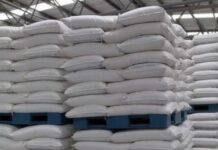UNCERTAIN WATERS: BETWEEN FAVORABLE CLIMATE AND CHALLENGING PRICE POLICIES
In a week made shorter by the Easter holiday, the sugar futures market in New York closed out Thursday with the contract maturing in May/2024 at 22.51 cents per pound. It is important to point out that the options for this contract expire in two weeks. However, they are not expected to cause great tension on the market, considering that the open positions at the exercise prices closest to the current level of the market do not point to major concerns.
The week registered a meaningful increase for May/2024, with a 65-point advancement equivalent to an increase of more than 14 dollars per ton. The spread between May and July appreciated 12 points reflecting the anxiety of the market players over the possibility of a delay in the start of the crop due to the rains in the crop-growing areas. Though a delay in the crop tends to strengthen the spread, the rainfalls are seen as being positive for the development of the sugarcane fields.
The market has been operating within a boring price range, with fluctuations caused mainly by transactions triggered by algorithms and computerized trading systems robots. These systems are fed by a variety of narratives that try to explain price movements many times without solid grounding. Despite these fluctuations, the market has kept its trajectory.
With the rainfall regularity and a climate without great changes, it seems unlikely that the sugar futures market in New York will go over the barrier of 23 and 24 cents per pound. However, there is a stronger support on the levels from 20 to 21 cents per pound. This support is especially influenced by production costs in Brazil’s competitor countries, such as India, where we foresee production cost at 20.50 cents per pound, and Thailand, with slightly lower costs.
A strong ethanol market in the second semester would be vital for the mills. However, the current energy landscape does not offer many hopes, despite a light breath of recovery of 8% seen in March. The true obstacle is the gas price policy, disastrously managed by the government, which has created an unbearable gap. With President Lula’s popularity in free fall, exacerbated by his frequent thoughtless statements, the possibility Petrobras will adjust the whopping discrepancy of 18% between the international price and the one practiced in the refineries seems more like an illusion than a realistic expectation.
The factors that hinder any potential for a high on the sugar market include: a) a sugarcane crop in the Center-South that, against the expectations, is set to be more promising than what was forecast, maybe not going through the projected drop of 8-9% in the early estimates; b) the oil market showing a negative carry higher than 10% per year, pointing to an absence of concern over possible shortage crises; c) the foreign corn sector, which is facing a 9% devaluation in the yearly accumulated and a 27% one over the last twelve months, increasing the pressure on North-American ethanol export and an increase in Brazilian hydrous production; d) the possibility of an increase in sugar Indian exports after the elections in May, a start expected in August/2024 – a challenge launched at a dinner in São Paulo to the first three that speak out; e) the possibility of funds starting to sell on the market; f) the gas price suppression by the government.
On the other hand, the possible accelerators of a price appreciation include: a) a climate that decides to turn its back on the sugarcane fields, preferring the drama of ruthless rains or droughts; b) the geopolitical theater that can always surprise the oil market with a new soap opera-like episode; c) the stellar emergence of a black swan which, for a change, decides to shock the market with its unpredictability; d) a fund manager with too much cash on hand who, at a moment of pure financial adrenaline, decides to buy the whole market…
But all joking aside, as you know, reality is pretty different when we put all the fundamentals on the table. And, based on what we have said over and over again, only the whimsical nature has the power to rewrite the script of the current market.
—
The recent global cocoa market faces a crisis with downward demand and profit reduction. Supply problems in Western Africa, especially in the Ivory Coast and Ghana, have contributed to that, causing an increase of 140% in prices in 2024, with a total high of 245% in a year. The situation has triggered the search for hedge strategies. The question is whether or not the Brazilian manufacturers have adopted adequate policies of risk management.
Risk management is not merely an additional component within the operational structure of companies that trade in commodities; it is the backbone of the entrepreneurial sustainability over the long term. However, it’s deeply alarming to see its recurrent and systematic negligence. Such disregard not only jeopardizes the financial viability of these entities, but it also underlines the urgent need to reevaluate and strengthen risk mitigation strategies, that way assuring the continuity and stability in the turbulent and unpredictable market of commodities. As you can see, this problem does not just hit some mills.
You all get some good rest and have a great Easter.
To read the previous episodes of World Sugar Market – Weekly Comment, click here
To get in touch with Mr. Arnaldo, write on arnaldo@archerconsulting.com.br












